Japanese-style baseball
Japanese-style baseball, or rubber-ball baseball, (Japanese: 軟式野球, romanized: Nanshiki yakyū, lit. 'soft baseball') is a game that was created in Japan and is derived from baseball. It uses a hard rubber ball instead of a regular baseball made of leather. It has been rendered in English in a variety of ways, including nankyu baseball (nankyu means 'soft ball' in Japanese), nanshiki baseball and rubber baseball. In a narrow sense, Japanese-style baseball is a game that uses a hollow rubber ball, and in a broad sense, it includes a semi-hard baseball where a hard ball's outer coating is replaced with rubber. In contrast, the ball used in softball is most often leather but is larger than a regular baseball.
Other than the use of a different ball, the rules of Japanese-style baseball and regular baseball are the same. However, the difference in the ball has a distinctive effect on the playing style and equipment, and also changes the way the players use their body.[1]
History

During the Meiji era (1868–1912), baseball introduced from the United States became established in Japan in national competitions for secondary schools, high schools, and colleges, and children enjoyed playing baseball using hard tennis balls. However, tennis balls had the drawback of being difficult to use due to problems with their durability and speed, and the number of people playing the sport gradually declined. In 1919, Toshin Rubber, a company based in Kobe, sold the world's first rubber baseball. As a result, the number of young people playing baseball started to increase again. In the following year, the Japan Association of Youth Baseball (大日本少年野球協会, Dai-nippon shōnen yakyū-kyōkai) was established in Kobe and a full-fledged national tournament for youth baseball was held. Then in 1925, a man called Haruno Yokoi (横井 春野, Yokoi Haruno) formed the same organization in Tokyo.
Ball types

The ball has undergone a number of revisions, but the current dimensions were set out in December 2016 by the Japan Rubber Baseball Association (公益財団法人全日本軟式野球連盟) and the Baseball Ball Manufacturers Association (野球ボール工業会). Two types are specified: type M (major) and type J (junior). Type M has a diameter of 71.5–72.5 millimetres (2.81–2.85 in). Meanwhile, type J has a diameter of 68.5–69.5 millimetres (2.70–2.74 in).[2]
In comparison, a regulation leather baseball is 73–75 millimetres (2.9–3.0 in) in diameter. An 11-inch ball used in softball has a diameter of about 89 millimetres (3.5 in).[3]
Global popularity

Japanese-style baseball is often played by university teams,[4] and there is a World University Japanese-style Baseball Tournament that takes place outside Japan. It was held in Guam in 2019. In addition, the International Boys Nankyu Baseball World Championship takes place annually.[5]
Cuba has its own version of Japanese-style baseball, and a similar type of baseball is also played in Taiwan.
References
- 軟式野球と硬式野球の違いって? SPOLABO’s webpage (in Japanese)
- ハートの新球、5つの秘密 Jiji Press Ltd.’s webpage (in Japanese)
- The Long History of Various Softball Sizes Decker Sports’ webpage
- What's New Japan University Nanshiki Baseball Federation webpage (in Japanese)
- Taiwan snags 12th IBA-Boys baseball championship in Japan Focus Taiwan webpage